
4 minute read
Free water cement Ratio: 0
Volume: 08 Issue: 07 | July 2021 www.irjet.net p-ISSN: 2395-0072
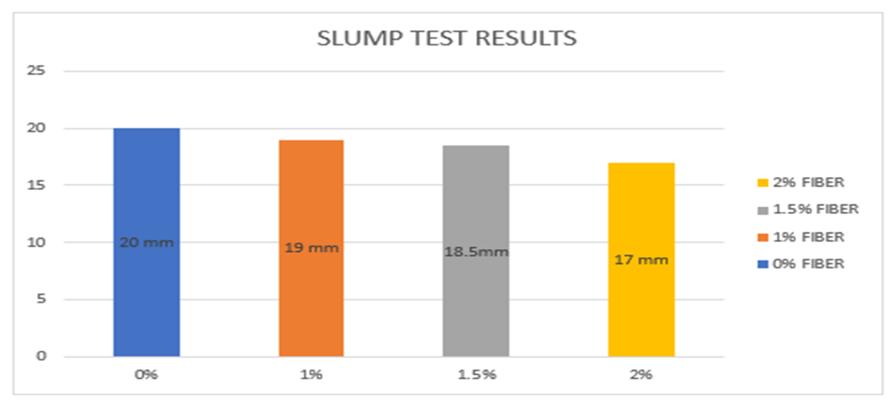
Advertisement
Figure 3Slump test results for the various percentage of waste steel fiber.
3.2 Crushing results of 7, 14 and 28-days curing concrete
After casting the cubes in standard dimension of 150 mm X 150 mm X 150 mm moulds, curing process divided into 3 groups of inspection which are 7, 14 and 28 days. After that it is tested using the crushing machinein concrete laboratory (Figure 4).
Figure 4 Crushing machinein the concrete laboratory.
Table 4 shows the results of the crushing test where it is found that as the curing days increases the strength of the concrete increases. It is also observed that as the percentage of steel increases between 1% to 2%. The 1% steel fiber with 7, 14 and 28-days curing shows the best result between all type of combination of percentage of steel with different curing days.
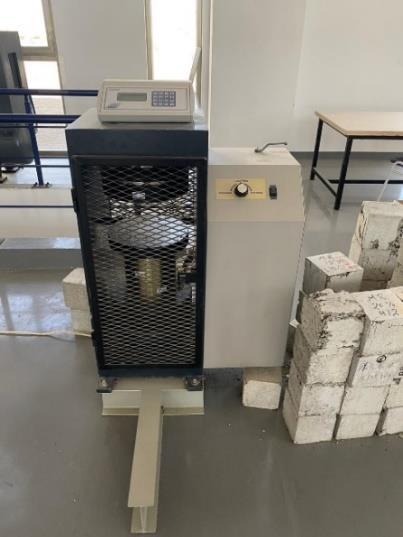
Volume: 08 Issue: 07 | July 2021 www.irjet.net p-ISSN: 2395-0072
Table 4 Final crushing results for all samples for 7,14 and 28-days curing
Figure 5 depicts the results distinctly for all the tested samples for the project. Where blue colour shows the 0 % steel wires, orange 1%, grey 1.5% and yellow shows the 2% of the steel wire for 7, 14 and 28 days.
Figure 5 Comparison of the results of all the samples with 1%,1.5% and 2% percentage of steel fibers with 7, 14 and 28 days.
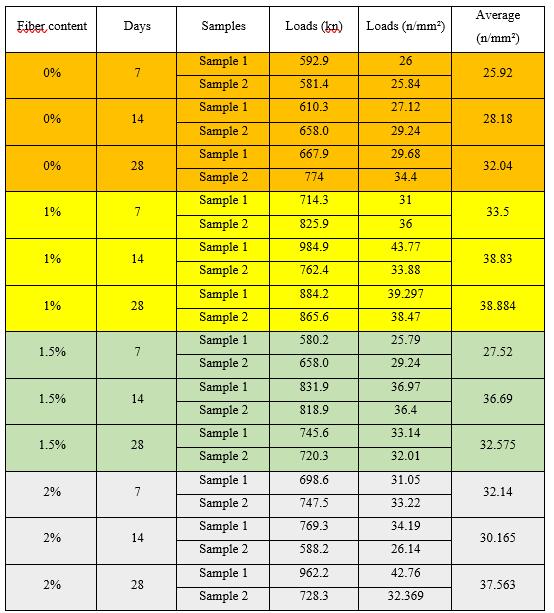
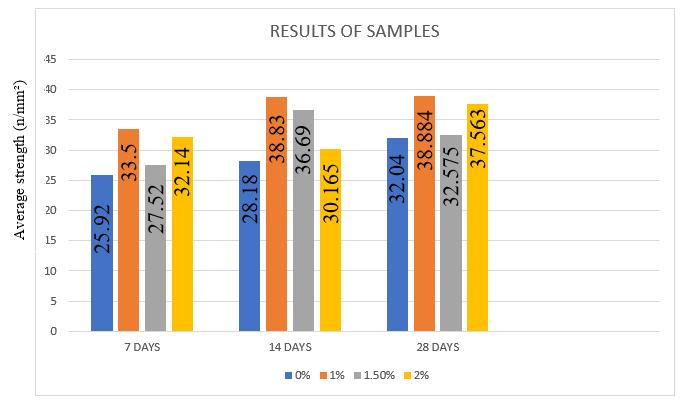
Volume: 08 Issue: 07 | July 2021 www.irjet.net p-ISSN: 2395-0072
3.3 Percentage change in the strength after 28 days
The percentage change = (Final value-Initial value)/ (Initial value) x 100
Positive sign indicates the increase in the strength of concrete while the negative sign indicates the decrease in the strength. Table 5 and Figure 6 shows the percentage changes occurred in the strength after 28 days.
Table 5 increase of strength per average results after 28 days
Fiber content % by weight
Average compressive strength (N/mm²) % Increase and decrease in compressive strength
0% 1% 1.5% 2% 32.04 38.884 32.575 37.563 + 21% -16% + 15.31
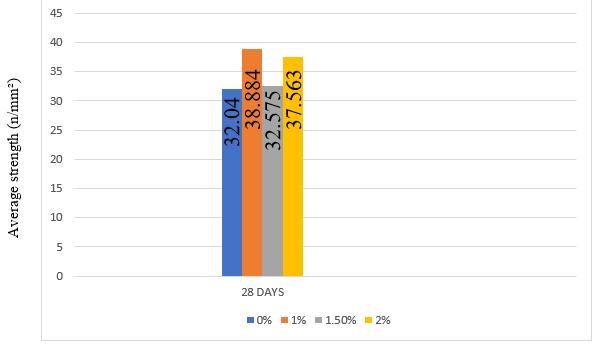
Figure 2The comparison of the percentage change of strength after 28 days.
4. Conclusions
1. According to the results it proves that 1 % of steel fibre in the concrete by its weight is the sufficient steel wire percentage to gain the maximum strength in the concretethan any other percentageof steel. Fluctuations in strength value started to occur after the 1 % of steel fibre hence the research can be done between 0.5% to 1% of steel fibre to gain the maximum strength.
2. The concrete is normally subjected to cracking in different conditions with respect to an extent of factors from the material quality used for mixture to the proportioning variations with the various specified used materials and percentage used in the mix.
3. The materials used for the tests may increase and reduce the strength of the reinforced concrete with respect to proportioning of the mix designed.
Volume: 08 Issue: 07 | July 2021 www.irjet.net p-ISSN: 2395-0072
References:
1) Ashish Shukla, Nakul Gupta, Kamal Kishore (2020), Experimental investigation on the effect of steel fiber embedded in marble dust based concrete, Materials Today: Proceedings26DOI: 10.1016/j.matpr.2020.02.607. 2) Dahake Ajay. (2016). Effect of Steel Fibers on Strength of Concrete. Journal of Engineering, science and
Management Education. 9. 45-51. 3) Jacek Domski, Jacek Katzer, Mateusz Zakrzewski, Tomasz Ponikiewski, (2017), Comparison of the mechanical characteristics of engineered and waste steel fiber used as reinforcement for concrete, Journal of Cleaner
Production158, 18-28. 4) Kamran Aghaee, Mohammad Ali Yazdi, (2014), Waste Steel Wires Modified Structural Lightweight Concrete,
Materials Research17(4):958-966, DOI: 10.1590/1516-1439.257413. 5) M.C. Nataraja, N. Dhang, A.P. Gupta (1999), Stress–strain curves for steel-fiber reinforced concrete under compression, Cement and Concrete Composites, Volume 21, Issues 5–6,pages 383-390, ISSN 0958-9465. 6) Milind V. Mohod, (2012), Performance of Steel Fiber Reinforced Concrete, International Journal of Engineering and Science ISSN: 2278-4721, Vol. 1, Issue 12, PP 01-04. 7) Song P.S., S Hwang, (2004), Mechanical properties of high-strength steel fiber-reinforced concrete, Construction and Building Materials,Volume 18, Issue 9,Pages 669-673,ISSN 0950-0618. 8) Targum Gehlot,Divanshu Seervi , Peeyush Chowdhary, (2017), Study of the Compressive Strength Behaviour of
Steel Fibre Reinforced Concrete Using Various Percentage of Steel Fibre. International Journal of Advanced
Research, 5(7):1940-1950, DOI: 10.21474/IJAR01/4925 9) Waqas Arshad Tanoli, Amjad Naseer, Fazli Wahab (2014), Effect of Steel Fibers on Compressive and Tensile
Strength of Concrete, International Journal of Advanced Structures and Geotechnical Engineering ISSN 2319-5347,
Vol. 03, No. 04, October 2014. 10) Yuanxun Zheng, Xiaolong Wu, Guangxian He, Qingfang Shang, Jianguo Xu, and Yikai Sun, (2018), Mechanical
Properties of Steel Fiber-Reinforced Concrete by Vibratory Mixing Technology, Fiber Reinforced Concrete with
Application in Civil Engineering.Volume 2018 |Article ID 9025715 | https://doi.org/10.1155/2018/9025715.


